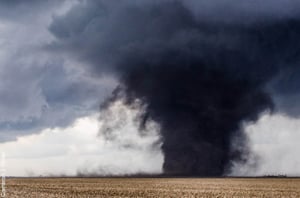By Sara Peters, Sr. Customer Communications & Brand Specialist, Fauske & Associates, LLC
Safety planning in a facility is expected. Experts look at the “what if” scenarios and try to create and implement procedures to mitigate the potential for damage. But what happens when a situation arises that a plant has not prepared for?
Mother Nature has come at the US hard in the last few years. Fires out west, multiple hurricanes in the gulf, deep freezes in the south, nor’ easters wreaking their own special havoc. To say that such extreme and changing weather patterns have caught pretty much everyone in the country off guard is an understatement. 
Yes, different weather events are expected in each season and prepared for accordingly. For example, where I live, tornado season is upon us and the drills and siren tests have begun since our region is tornado prone. But, that doesn’t mean that tornadoes and the wind and flooding issues that accompany such strong storms are the only type of catastrophic events we could face. After all, the New Madrid fault line does run through the southern tip of my state. And, even though the occurrence of an earthquake might seem minimal for now, It is not all together unlikely. Have the manufacturing facilities and chemical plants in the area factored the possibility of an earthquake into their facility safety planning? I would hope so, but the reality is planning for a tornado is probably addressed more in their plant safety planning because the threat is greater.
Although a good safety expert will consider numerous situations in their planning efforts, truth be told, you can’t plan for every scenario, no matter how hard you might try. And, even with the most current data and statistics at your fingertips, you cannot estimate the severity of every scenario. No one could have predicted the full extent of the destruction that weather has wrought in recent months/years. In the end, not only are private citizens left to deal with the aftermath, but so too is industry.
This recent article published in Chemical Processing addresses the impact of recent severe and extreme weather events on the chemical industry. It also serves as a good reminder of the importance of constantly reviewing process safety planning strategies to ensure your plan is keeping up with the inevitable changes.
If you happen to be from Illinois, you might be surprised to read "Illinois Emergency Management Says Be Ready for the Big One With Earthquake Preparedness." Search the net for your state to find similar. For a list of recent earthquakes near your state, click here and select your state.
A key factor in such planning is to understand the volatility of the materials you use and the safety measures required to keep your equipment operational. A combustible dust hazard analysis (DHA), and process hazards analysis (PHA) along with dust and chemical characterization can help identify potential hazards. Add to that, an understanding of the structural considerations brought about by aging facilities and urban growth in surrounding areas for the most comprehensive Process Safety Management (PSM) approach. The safety plan that is developed should be revisited regularly to account for such variables.
I urge all of you to revisit your safety planning in light of the most recent wave of environmental disasters. If you need help with PHAs, DHAs or testing along with other important PSM assessments and tools, let us know. Safety is our passion and we are here to help.

